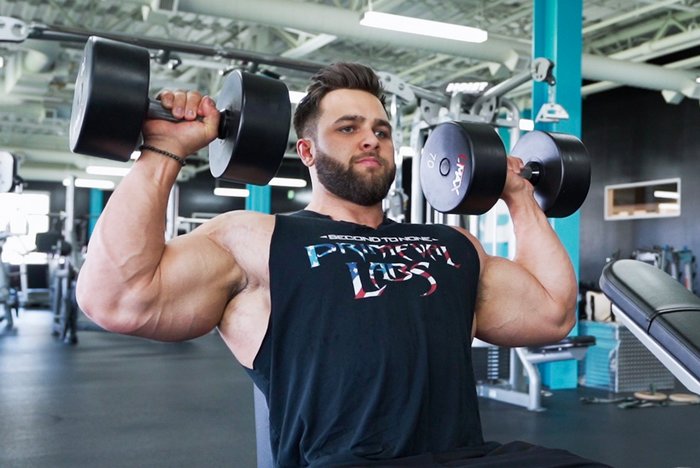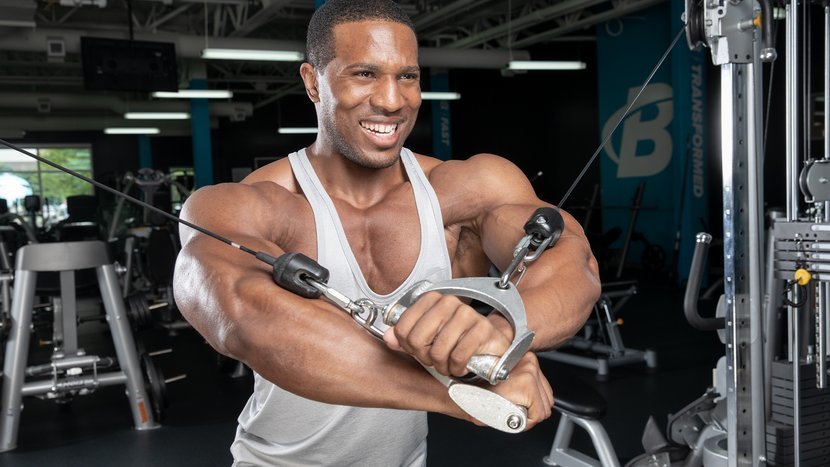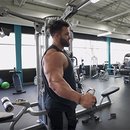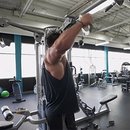If you're familiar with Grimey-style training, you know Regan Grimes loves higher-volume workouts, and if you push yourself the way he does, the torture is worth the price. This style of training helps flood the muscles with blood, enhances cellular swelling (which helps drive muscle growth), creates a ton of time under tension (essential for getting stubborn shoulders to grow), and generates a tremendous muscle pump.
See if you can handle this workout—and use his tips below! Getting it right with shoulder training can be trickier than you think.

BodyFit
$6.99/month- 2,500+ expert-created single workouts
- 3,500+ how-to exercise videos
- Detailed workout instruction
- Step-by-step workout tips
- Training at gym or at home
- Access to Workout Plans
- Access to Bodyfit App
- Store Discounts
Already have a Bodybuilding.com account with BodyFit? Sign In

What comes with BodyFit?

- Instructional Videos
Don't risk doing a workout improperly! Avoid injury and keep your form in check with in-depth instructional videos.

- How-to Images
View our enormous library of workout photos and see exactly how each exercise should be done before you give it a shot.

- Step-by-Step Instructions
Quickly read through our step-by-step directions to ensure you're doing each workout correctly the first time, every time.
Training Tips
Rear Delt Cable Fly
Conventional shoulder workouts all start pretty much the same—emphasizing the front delts with front raises or some type of overhead press. But here's the thing: If you bench press or train chest often, your front delts are already getting hit pretty hard. Furthermore, most lifters perform little to no direct rear-delt training, save for a few throwaway sets of reverse pec-deck flyes after they've done all of their other shoulder training.
Not only does the lack of rear-delt work prevent you from attaining the "3D" look, it puts you at risk for shoulder injuries due to the imbalance between the size and strength of the front versus rear delts.
Grimes, on the other hand, likes to flip shoulder training on its head and begin with an exercise for the rear delts. This enables you to attack them with greater intensity and focus—as you are fresh both mentally and physically—and finally get some growth in this highly underemphasized muscle group.
Grimes' take on the conventional rear-delt fly is to perform a 3-way fly, where he rotates between low, middle, and high positions on each rep. Using multiple angles on the rear-delt fly gives you the greatest possible overall growth.

Forward-Leaning Dumbbell Upright Row
When it comes to training the side delts, we tend to use only isolation movements, but the upright row is a compound exercise that offers fantastic overload to the side and rear delts—if you perform it correctly. Over the years, the upright row has taken a beating from coaches and trainers who fear that it damages and degrades the shoulder joint. That certainly can happen if you use poor technique.

By using dumbbells, bringing your elbows out to the sides, and stopping the movement when your elbows are in line with your shoulders, you help limit the stress imposed on the shoulders and wrists.
Grimes has his own version of the movement, where he rows with a bit of a forward lean. By tilting his torso like that, he turns the upright row into a hybrid upright/rear-delt row that blasts both the side and rear delts.
As with all versions of the upright row, make sure you're initiating the movement from the elbows, not the hands or wrists. This subtle change in thinking will help you to pull more with the muscles of the side and rear delts and limit the involvement of the biceps, brachialis, and forearm.
Alternating Seated Dumbbell Lateral Raise
Lateral, or side, raises are one of the most common exercises included in shoulder workouts, and they're also one of the most poorly executed exercises. Two cardinal mistakes lifters make when performing lateral raises are using a ton of body English to get the weight up (on account of selecting a weight that is too heavy) and not leading with the elbow.
To help combat the body English issue, Grimes suggests performing the exercise seated and in an alternating fashion. As soon as the first arm reaches the bottom, initiate the movement with the other arm. Since you're only working one side at a time, you're forced to stabilize your body and resist being thrown off balance.
Regarding not leading with the elbow, when you perform lateral raises by leading with the wrists and hands, you limit your range of motion and, thereby, the involvement of the side delts. Basically, you're wasting your time with the exercise, since the whole purpose is to train the side delts, and you're also placing unnecessary stress on the rotator cuffs.
Initiating the lateral raise from the elbow maintains the tension on your delts first and foremost, minimizing the stress placed on the rotator cuff.
Seated Dumbbell Shoulder Press
The dumbbell shoulder press is a staple for building muscle and strength in the delts. You're probably pretty well versed in performing this exercise or some other variation of the overhead press, but did you realize that the position of your elbows determines how much contribution you get from the side delts? The farther your elbows are in front of your body, the more you stress the front delts. As you bring your elbows farther back and out to the sides, the side delts are more involved.

If you have dealt with "cranky" shoulders in the past, your best bet is to keep your elbows and upper arms more in front of your torso than out to the sides, or possibly halfway between. The natural angle of the glenoid fossa of the scapula is slightly forward, so by doing your dumbbell shoulder presses with your elbows more to the sides, you're working against the natural alignment of your anatomy and increasing the risk of damaging the delicate structures around the shoulder girdle.
For increased time under tension (aka an added challenge), do not allow your elbows to drop below parallel during the eccentric portion of the lift. This helps maintain prolonged tension on the delts. When your elbows drop below parallel, a common performance error, it removes tension from the deltoids and detracts from your growth long term.
Single-Arm Cross-Body Cable Front Raise
To cap off this delt workout, Grimes performs an "curved" front raise, using a single-hand cable attachment connected to a low pulley. To perform these, start by grasping the cable attachment. Face away from the pulley and take one step forward so that your working arm is behind your body in the pre-stretch position. Starting there places tension on the deltoids from the outside and allows for a greater range of motion and total work completed—meaning bigger, better gains.
Raise your arm up and out in a curved or arcing motion, finishing with it in front of your body. As you lower the weight, follow the same arcing motion in reverse.
This twist on the conventional forward-facing cable front raise gives you added tension on the side delt, which is the most stubborn of the three heads in terms of shoulder growth for the majority of lifters.
As with any type of shoulder raise—be it front, side, or rear—avoid the rookie mistake of fully extending your arm and locking out your elbow on this exercise. When you lock out your elbow, you place a tremendous amount of pressure on the elbow joint.
Instead, keep a slight bend in your elbow and lock that position in place to perform your single-arm cross-body front raises. When you allow the angle between your lower and upper arm to open and close during the exercise, you involve the auxiliary muscles (like the triceps) and reduce tension on the delts.






